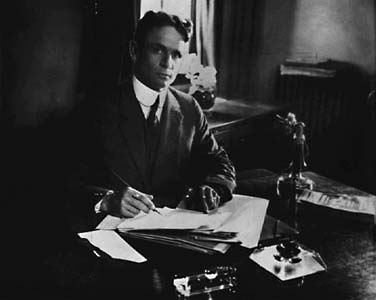Search | Image Archive | Reference | Communities | POV | Lesson Plans | Credits
 The revolution that turned the semi-arid Canadian prairies into viable farmland was accomplished through the application of scientific methodologies to the art of farming.
The revolution that turned the semi-arid Canadian prairies into viable farmland was accomplished through the application of scientific methodologies to the art of farming.
One of the more prominent figures of this scientific revolution was agronomist John Bracken. Bracken had grew up in southern Ontario and was a graduate of the Ontario Agricultural College at Guelph. He came to Saskatchewan in 1906 where he worked for the Dominion Agricultural Extension Services and served as a professor at the Saskatchewan Agricultural College. He left Saskatchewan in 1920 to become head of the Manitoba Agricultural College. Very early, he made a name for himself not just as a research scientist, but as a scientist sympathetic to the practical difficulties of farming.
His books Crop Production in Western Canada (1920) and Dry Farming in Western Canada (1921) became the definitive scientific texts on dryland farming and water conservation. They covered such topics as moisture conservation, tillage techniques, summer fallowing, crop rotation, and weed control. These books encapsulated the research conducted by him and other Ontario born farmers and represented the knowledge through which the marginal lands of the semi-arid prairie became some of the most productive farmland on the continent.
Bracken's books were complemented by those of Seager Wheeler who in 1919 published Seager Wheeler's Book on Profitable Grain Growing. This was a practical guide for the prairie farmer, written in plain language and much less academic than the work of Bracken. It gave precise details on all aspects of dryland farming, and put particular stress on methods of deep ploughing and seed and root-bed preparation. He was also a key promoter of Marquis Wheat and other hardy strains that thrived in the dry belt. The success of Wheeler's methods was evident in the many prizes he won at agricultural exhibitions.
Bracken left the Manitoba Agricultural College to begin a new career in politics in 1922. He was elected to the provincial legislature in that year under the banner of the United Farmers of Manitoba. The UFM was a loose coalition primarily of farmers frustrated with the traditional parties. With candidates in less than two thirds of provincial ridings, a limited campaign, and no leader, the UFM won a majority. Bracken, who admitted that before the election he had never voted, emerged as leader. He served as premier until 1942, first as leader of the UFM and later as leader of the Progressive Party. In 1942, the Progressives merged with the federal Conservatives to form the Progressive Conservative Party, and Bracken left provincial politics to serve as the leader of the federal opposition until 1948.
Page revised: 27 August 2009